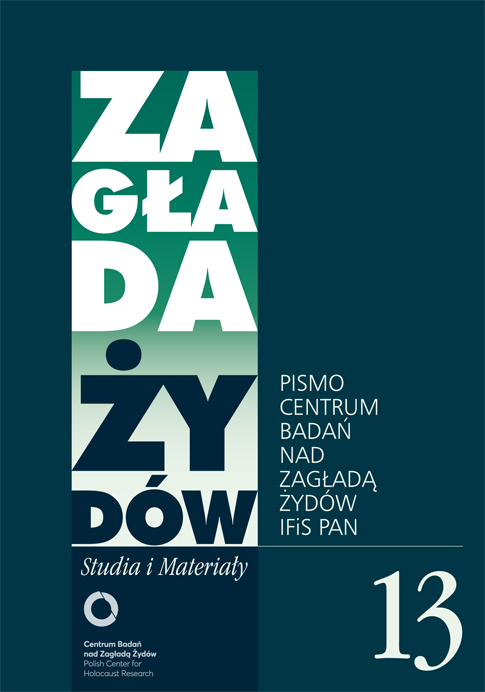Bernard Mark, powstanie w getcie warszawskim i proces Jürgena Stroopa
Zagłada Żydów. Studia i Materiały, Nr 13 (2017), Strony: 181-202
Data zgłoszenia: 2020-10-17Data publikacji: 2017-12-03
 https://doi.org/10.32927/ZZSiM.356
https://doi.org/10.32927/ZZSiM.356
Abstrakt
Jürgen Stroop, the SS general who led the liquidation of the Warsaw Ghetto and the suppression of the Warsaw Ghetto Uprising in April–May 1943, was convicted by a Polish court in 1951 and executed in 1952. Bernard (Ber) Mark (1908–1966), Holocaust historian and director of the Jewish Historical Institute in Warsaw, provided expert testimony for the prosecution at Stroop’s trial. Mark felt constrained to graft a communist-inflected narrative onto his account of the Warsaw Ghetto Uprising and to shoehorn it into his expert testimony in court and then into his interpretation of the trial for a Jewish audience. He did his best to give the Jewish Fighting Organization, which spearheaded the uprising, and its Jewish fighters their due at a time when expression of unvarnished appreciation for Jewish heroism was risky, even while he was paying overrated tribute to the communist underground for its assistance to the Jewish rebels during the uprising. But he always stopped short of the line between conformity to and defiance of the communist regime
Słowa kluczowe
Bernard Mark , Żydowski Instytut Historyczny , powstanie w getcie warszawskim , proces Jürgena Stroopa
Licencja
Prawa autorskie (c) 2017 Autor&"Zagłada Żydów. Studia i Materiały"

Utwór dostępny jest na licencji Creative Commons Uznanie autorstwa 4.0 Międzynarodowe.
https://creativecommons.org/licenses/by/4.0
Czasopismo publikowane jest w standardzie Diamond Open Access na licencji CC-BY-4.0 Deed - Uznanie autorstwa 4.0 Międzynarodowa - Creative Commons
Inne teksty tego samego autora
- Gabriel Finder, Proces Szepsla Rotholca a polityka kary w następstwie Zagłady , Zagłada Żydów. Studia i Materiały: Nr 2 (2006)
- Gabriel Finder, Svenja Bethke, Dance on the Razor’s Edge:Crime and Punishment in the Nazi Ghettos [Gabriel N. Finder] , Zagłada Żydów. Studia i Materiały: Nr 17 (2021)
Podobne artykuły
- Justyna Kowalska-Leder, Kłopotliwa kategoria. Wokół tomu Świadek: jak się staje, czym jest? , Zagłada Żydów. Studia i Materiały: Nr 16 (2020)
- Joanna Gubała-Czyżewska, Upamiętnienia Łodzi żydowskiej – w jaki sposób przeszłość uobecnia się w teraźniejszości , Zagłada Żydów. Studia i Materiały: Nr 16 (2020)
- Anna Wylegała, Recenzja: John-Paul Himka, Ukrainian Nationalists and the Holocaust: OUN and UPA’s Participation in the Destruction of Ukrainian Jewry, 1941–1944, seria „Ukrainian Voices”, t. 12, Stuttgart: ibidem, 2021, 540 s. , Zagłada Żydów. Studia i Materiały: Nr 18 (2022)
- Marcin Wilk, Marta Prochwicz, Janina Ludawska in memoriam , Zagłada Żydów. Studia i Materiały: Nr 16 (2020)
- Agnieszka Haska, Yorai Linenberg, Jewish Soldiers in Nazi Captivity: American and British Prisoners of War during the Second World War , Zagłada Żydów. Studia i Materiały: Nr 20 (2024)
- Bartłomiej Krupa, O nieobecności Zagłady, czyli czytanie Rozmów z katem Kazimierza Moczarskiego , Zagłada Żydów. Studia i Materiały: Nr 7 (2011)
- Andrzej Żbikowski, Marcin Urynowicz, Adam Czerniaków 1880–1942. Prezes getta warszawskiego, Instytut Pamięci Narodowej, Warszawa 2009 , Zagłada Żydów. Studia i Materiały: Nr 6 (2010)
- Jan Grabowski, Dariusz Libionka, Reports on the Jews Apprehended in Warsaw During May–July 1943 Submitted by the ‘Praga’ District of the Polish Police , Zagłada Żydów. Studia i Materiały: Nr Holocaust Studies and Materials (2017)
- Katarzyna Chmielewska, Pamięć wielokierunkowa i agoniczna a polityka pamięci , Zagłada Żydów. Studia i Materiały: Nr 17 (2021)
- Bartłomiej Krupa, Critical History and its ‘Shadow Cabinet’. Polish Historiography and the Holocaust during 2003–2013 , Zagłada Żydów. Studia i Materiały: Nr Holocaust Studies and Materials (2017)
<< < 1 2 3 4 5 6 7 8 9 10 11 12 13 14 15 16 17 18 19 20 21 22 23 24 25 26 27 28 29 30 31 32 33 34 35 36 37 38 39 40 41 42 43 44 45 46 47 48 > >>
Możesz również Rozpocznij zaawansowane wyszukiwanie podobieństw dla tego artykułu.
 English
English
 Język Polski
Język Polski



 https://orcid.org/0000-0003-2829-3979
https://orcid.org/0000-0003-2829-3979

